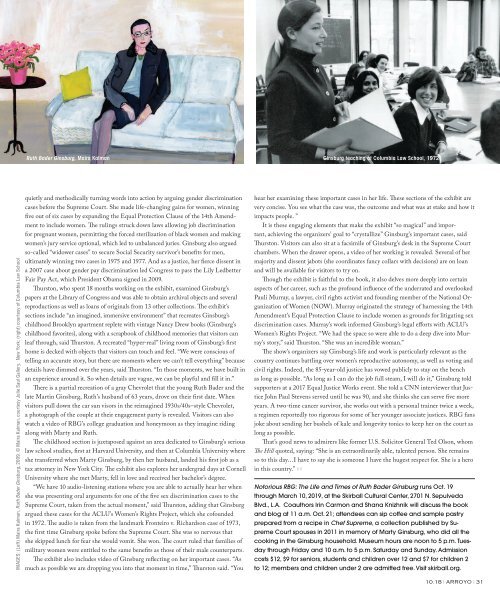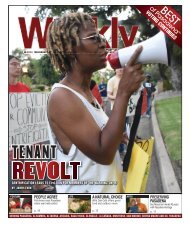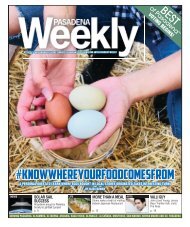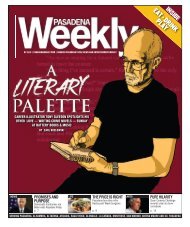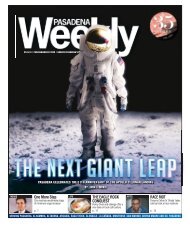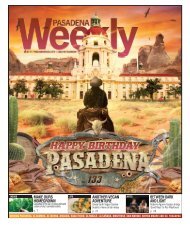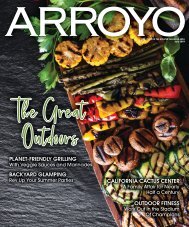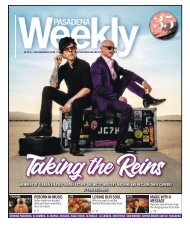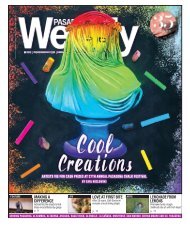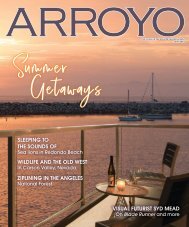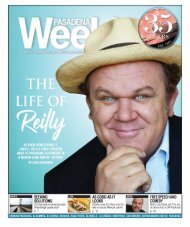October Arroyo 2018
Create successful ePaper yourself
Turn your PDF publications into a flip-book with our unique Google optimized e-Paper software.
Ruth Bader Ginsburg, Maira Kalman Ginsburg teaching at Columbia Law School, 1972<br />
IMAGES: (Left) Maira Kalman, Ruth Bader Ginsburg, 2009. © Maira Kalman, courtesy Julie Saul Gallery, New York; (right) courtesy of Columbia Law School<br />
quietly and methodically turning words into action by arguing gender discrimination<br />
cases before the Supreme Court. She made life-changing gains for women, winning<br />
five out of six cases by expanding the Equal Protection Clause of the 14th Amendment<br />
to include women. The rulings struck down laws allowing job discrimination<br />
for pregnant women, permitting the forced sterilization of black women and making<br />
women’s jury service optional, which led to unbalanced juries. Ginsburg also argued<br />
so-called “widower cases” to secure Social Security survivor’s benefits for men,<br />
ultimately winning two cases in 1975 and 1977. And as a justice, her fierce dissent in<br />
a 2007 case about gender pay discrimination led Congress to pass the Lily Ledbetter<br />
Fair Pay Act, which President Obama signed in 2009.<br />
Thurston, who spent 18 months working on the exhibit, examined Ginsburg’s<br />
papers at the Library of Congress and was able to obtain archival objects and several<br />
reproductions as well as loans of originals from 13 other collections. The exhibit’s<br />
sections include “an imagined, immersive environment” that recreates Ginsburg’s<br />
childhood Brooklyn apartment replete with vintage Nancy Drew books (Ginsburg’s<br />
childhood favorites), along with a scrapbook of childhood memories that visitors can<br />
leaf through, said Thurston. A recreated “hyper-real” living room of Ginsburg’s first<br />
home is decked with objects that visitors can touch and feel. “We were conscious of<br />
telling an accurate story, but there are moments where we can’t tell everything” because<br />
details have dimmed over the years, said Thurston. “In those moments, we have built in<br />
an experience around it. So when details are vague, we can be playful and fill it in.”<br />
There is a partial recreation of a gray Chevrolet that the young Ruth Bader and the<br />
late Martin Ginsburg, Ruth’s husband of 63 years, drove on their first date. When<br />
visitors pull down the car sun visors in the reimagined 1930s/40s–style Chevrolet,<br />
a photograph of the couple at their engagement party is revealed. Visitors can also<br />
watch a video of RBG’s college graduation and honeymoon as they imagine riding<br />
along with Marty and Ruth.<br />
The childhood section is juxtaposed against an area dedicated to Ginsburg’s serious<br />
law school studies, first at Harvard University, and then at Columbia University where<br />
she transferred when Marty Ginsburg, by then her husband, landed his fi rst job as a<br />
tax attorney in New York City. The exhibit also explores her undergrad days at Cornell<br />
University where she met Marty, fell in love and received her bachelor’s degree.<br />
“We have 10 audio-listening stations where you are able to actually hear her when<br />
she was presenting oral arguments for one of the five sex discrimination cases to the<br />
Supreme Court, taken from the actual moment,” said Thurston, adding that Ginsburg<br />
argued these cases for the ACLU’s Women’s Rights Project, which she cofounded<br />
in 1972. The audio is taken from the landmark Fronteiro v. Richardson case of 1973,<br />
the first time Ginsburg spoke before the Supreme Court. She was so nervous that<br />
she skipped lunch for fear she would vomit. She won. The court ruled that families of<br />
military women were entitled to the same benefits as those of their male counterparts.<br />
The exhibit also includes video of Ginsburg reflecting on her important cases. “As<br />
much as possible we are dropping you into that moment in time,” Thurston said. “You<br />
hear her examining these important cases in her life. These sections of the exhibit are<br />
very concise. You see what the case was, the outcome and what was at stake and how it<br />
impacts people. ”<br />
It is these engaging elements that make the exhibit “so magical” and important,<br />
achieving the organizers’ goal to “crystallize” Ginsburg’s important cases, said<br />
Thurston. Visitors can also sit at a facsimile of Ginsburg’s desk in the Supreme Court<br />
chambers. When the drawer opens, a video of her working is revealed. Several of her<br />
majority and dissent jabots (she coordinates fancy collars with decisions) are on loan<br />
and will be available for visitors to try on.<br />
Though the exhibit is faithful to the book, it also delves more deeply into certain<br />
aspects of her career, such as the profound influence of the underrated and overlooked<br />
Pauli Murray, a lawyer, civil rights activist and founding member of the National Organization<br />
of Women (NOW). Murray originated the strategy of harnessing the 14th<br />
Amendment’s Equal Protection Clause to include women as grounds for litigating sex<br />
discrimination cases. Murray’s work informed Ginsburg’s legal efforts with ACLU’s<br />
Women’s Rights Project. “We had the space so were able to do a deep dive into Murray’s<br />
story,” said Thurston. “She was an incredible woman.”<br />
The show’s organizers say Ginsburg’s life and work is particularly relevant as the<br />
country continues battling over women’s reproductive autonomy, as well as voting and<br />
civil rights. Indeed, the 85-year-old justice has vowed publicly to stay on the bench<br />
as long as possible. “As long as I can do the job full steam, I will do it,” Ginsburg told<br />
supporters at a 2017 Equal Justice Works event. She told a CNN interviewer that Justice<br />
John Paul Stevens served until he was 90, and she thinks she can serve five more<br />
years. A two-time cancer survivor, she works out with a personal trainer twice a week,<br />
a regimen reportedly too rigorous for some of her younger associate justices. RBG fans<br />
joke about sending her bushels of kale and longevity tonics to keep her on the court as<br />
long as possible.<br />
That’s good news to admirers like former U.S. Solicitor General Ted Olson, whom<br />
The Hill quoted, saying: “She is an extraordinarily able, talented person. She remains<br />
so to this day…I have to say she is someone I have the hugest respect for. She is a hero<br />
in this country.” ||||<br />
Notorious RBG: The Life and Times of Ruth Bader Ginsburg runs Oct. 19<br />
through March 10, 2019, at the Skirball Cultural Center, 2701 N. Sepulveda<br />
Blvd., L.A. Coauthors Irin Carmon and Shana Knizhnik will discuss the book<br />
and blog at 11 a.m. Oct. 21; attendees can sip coffee and sample pastry<br />
prepared from a recipe in Chef Supreme, a collection published by Supreme<br />
Court spouses in 2011 in memory of Marty Ginsburg, who did all the<br />
cooking in the Ginsburg household. Museum hours are noon to 5 p.m. Tuesday<br />
through Friday and 10 a.m. to 5 p.m. Saturday and Sunday. Admission<br />
costs $12, $9 for seniors, students and children over 12 and $7 for children 2<br />
to 12; members and children under 2 are admitted free. Visit skirball.org.<br />
10.18 | ARROYO | 31


